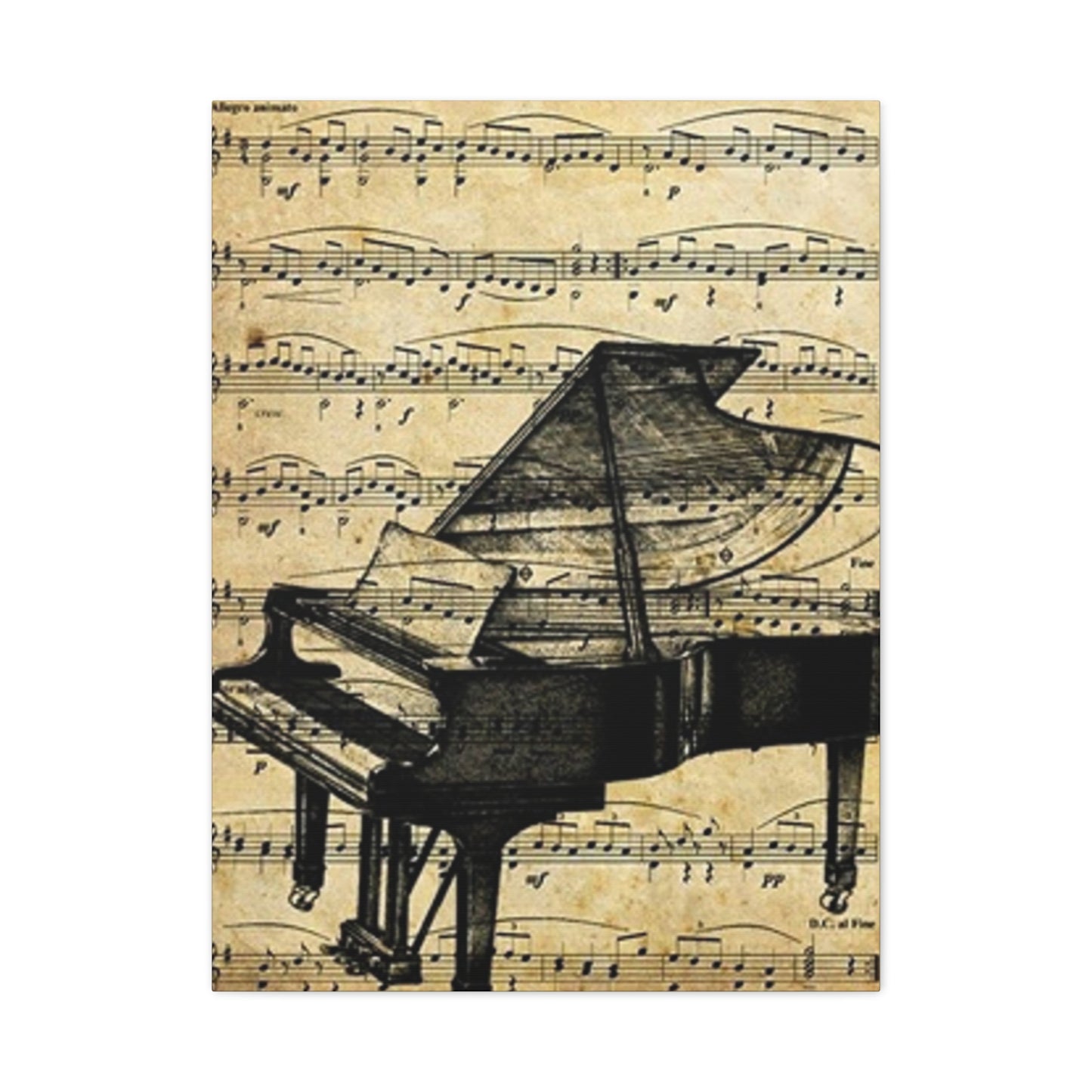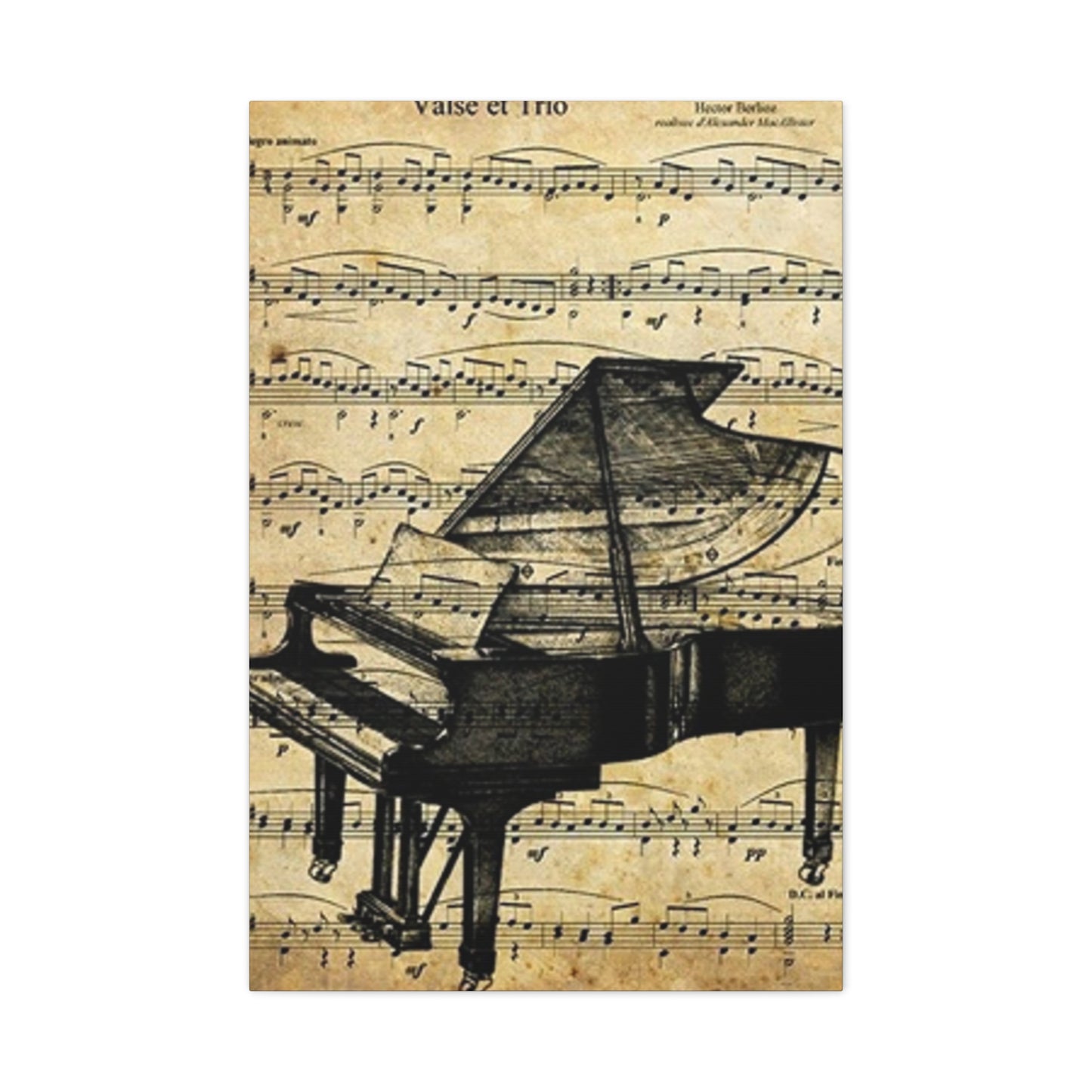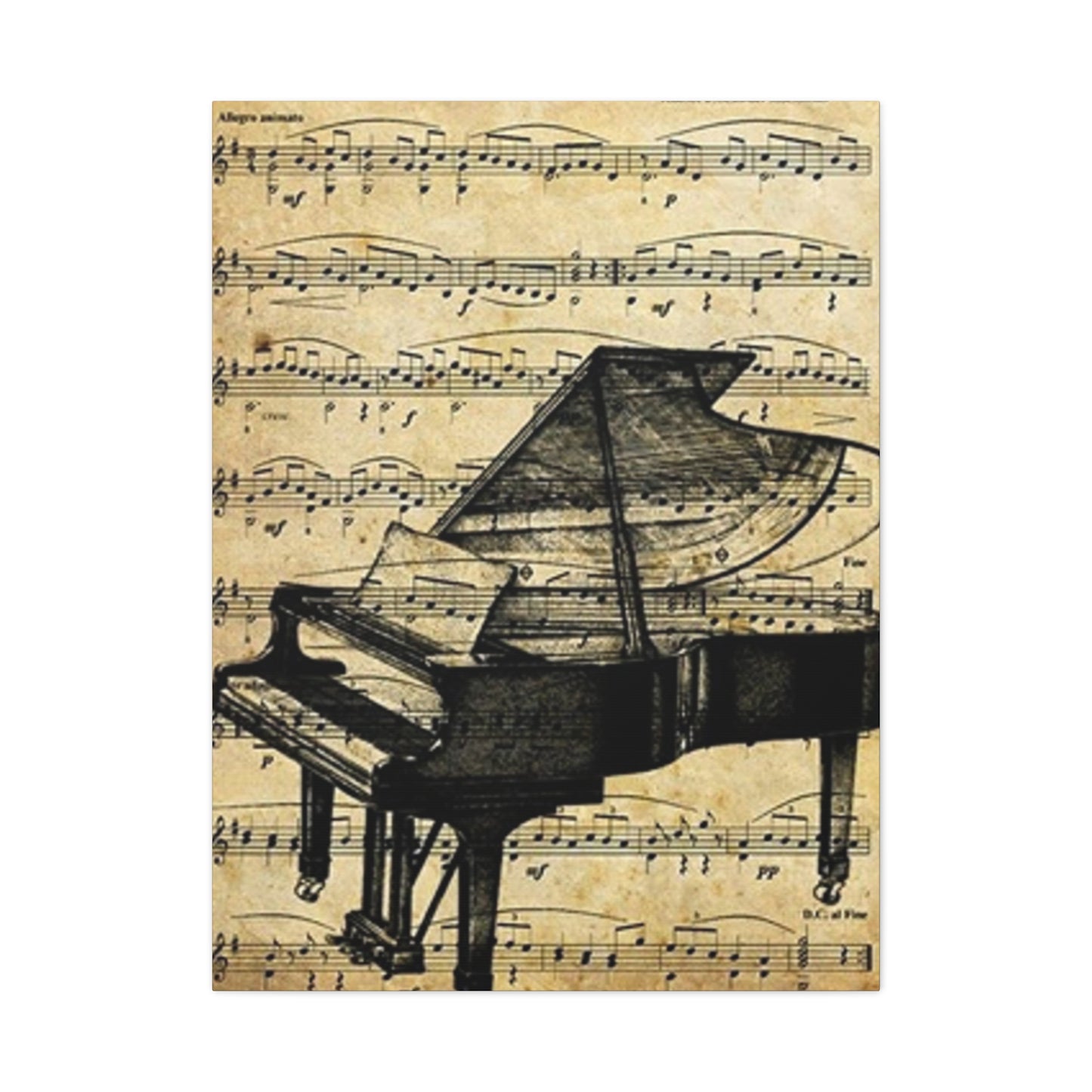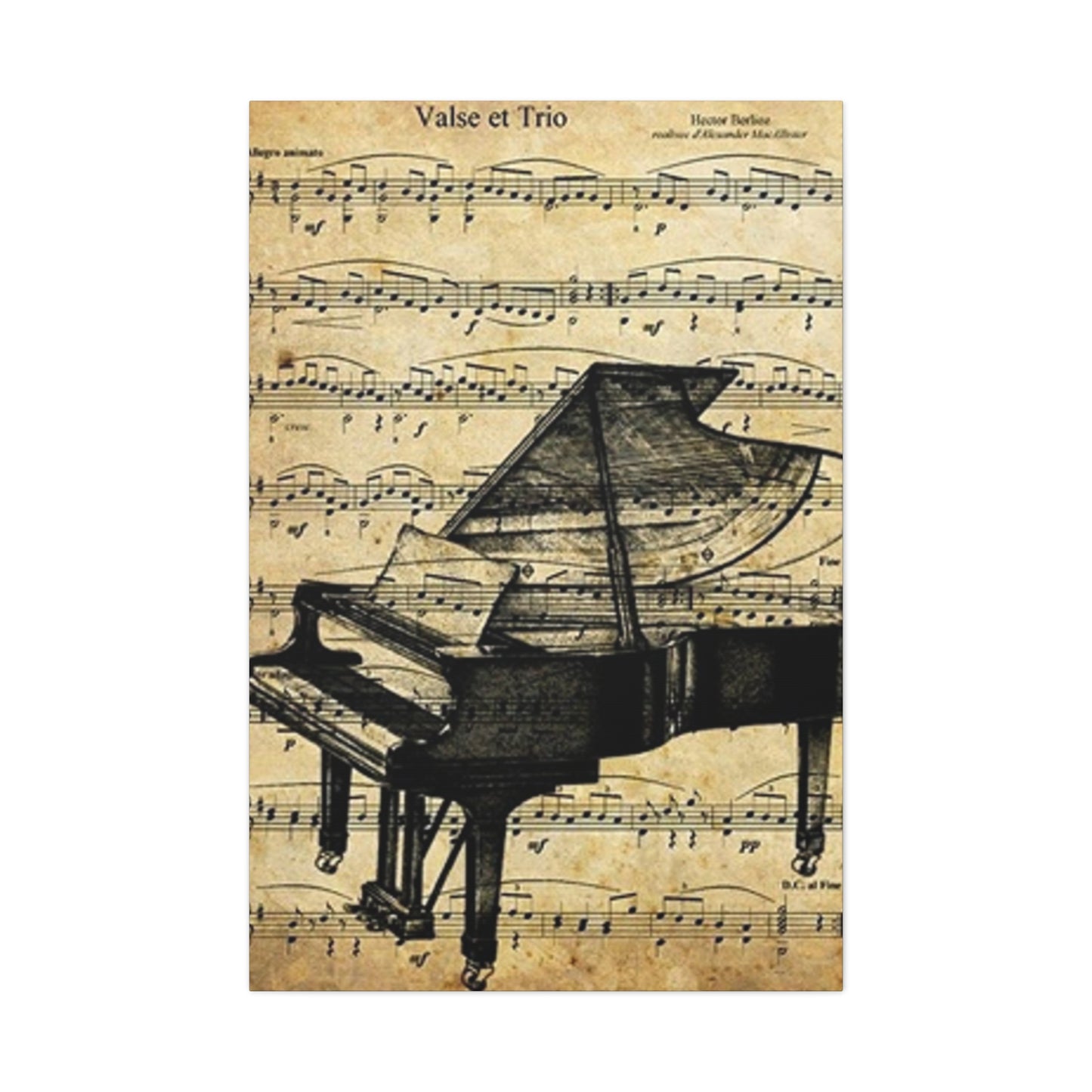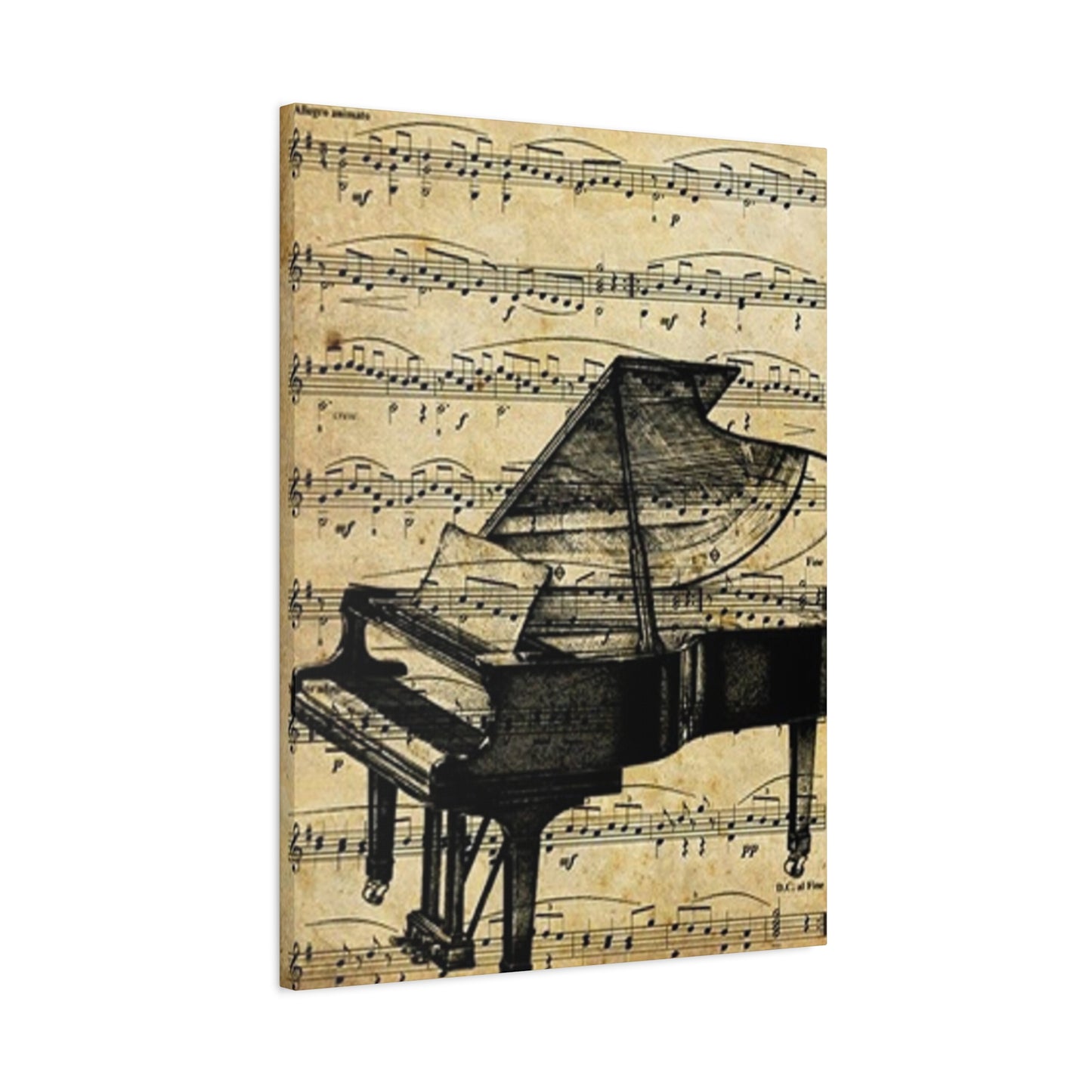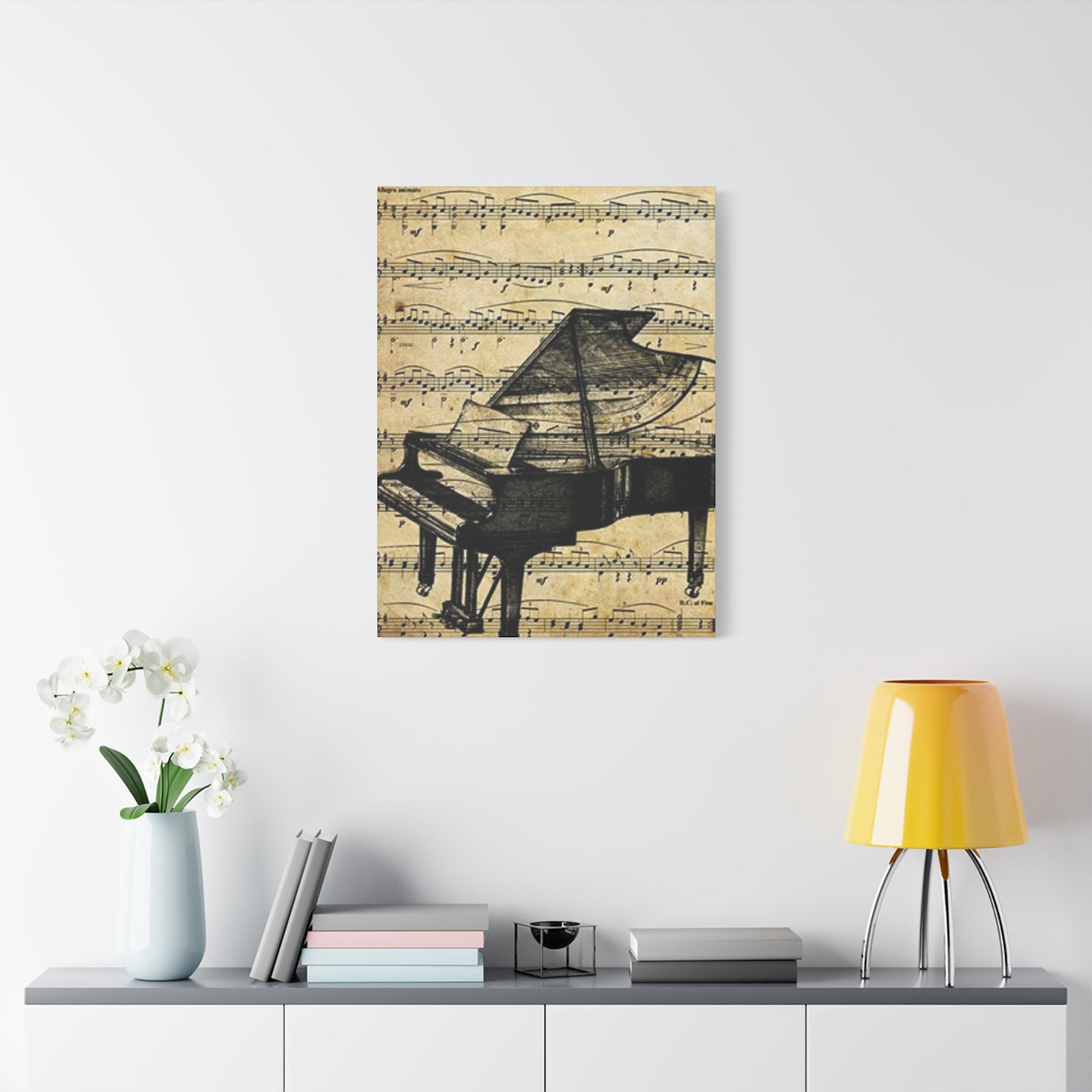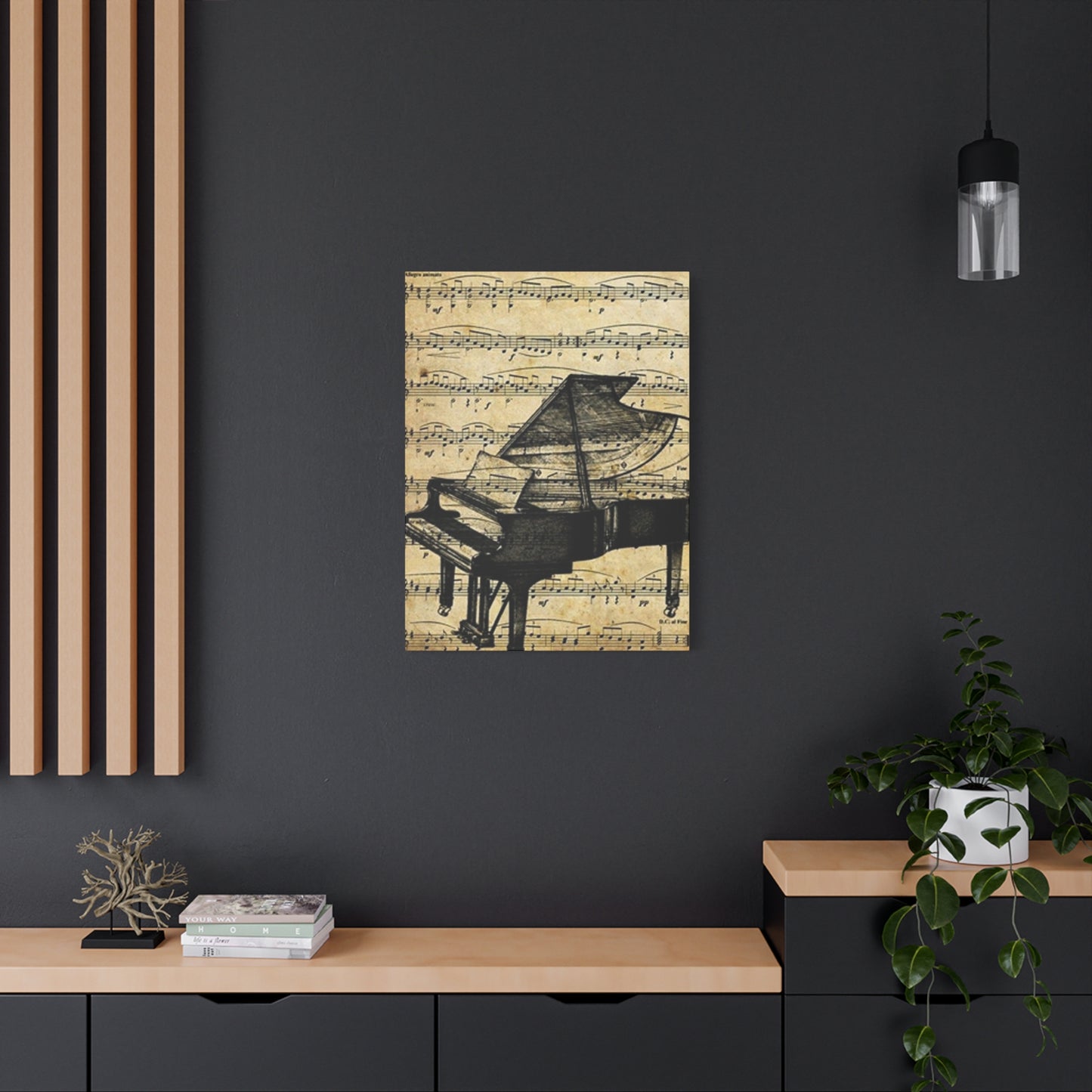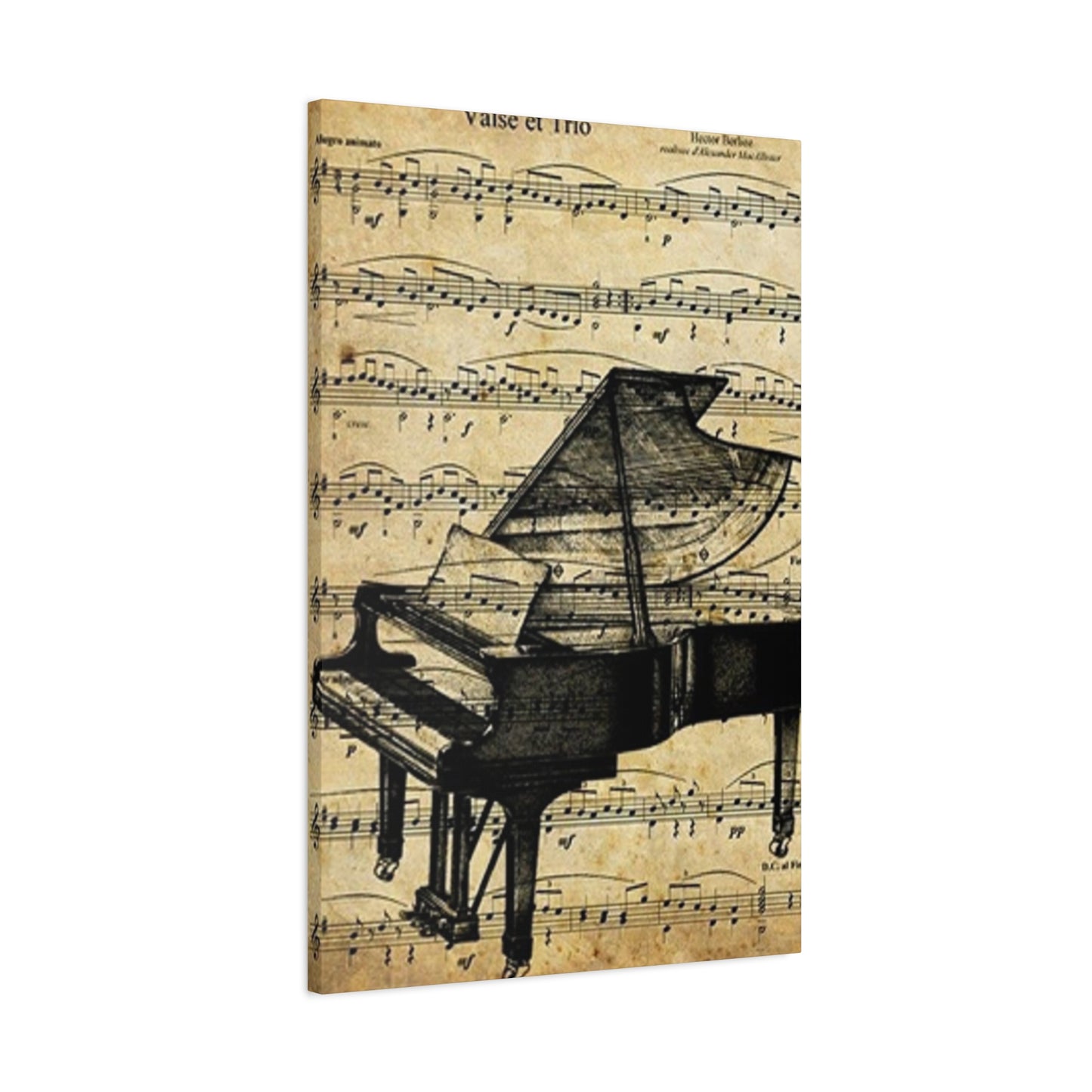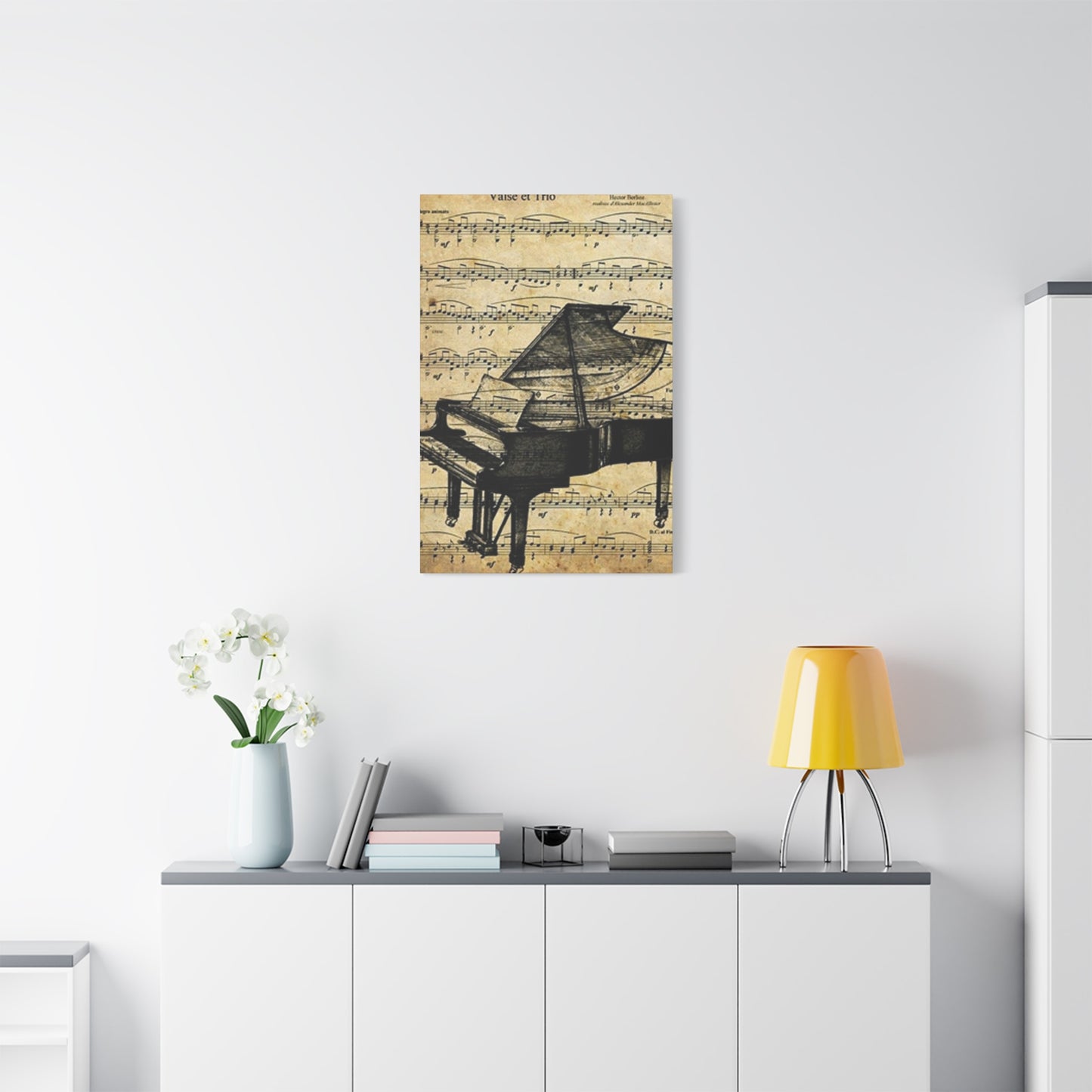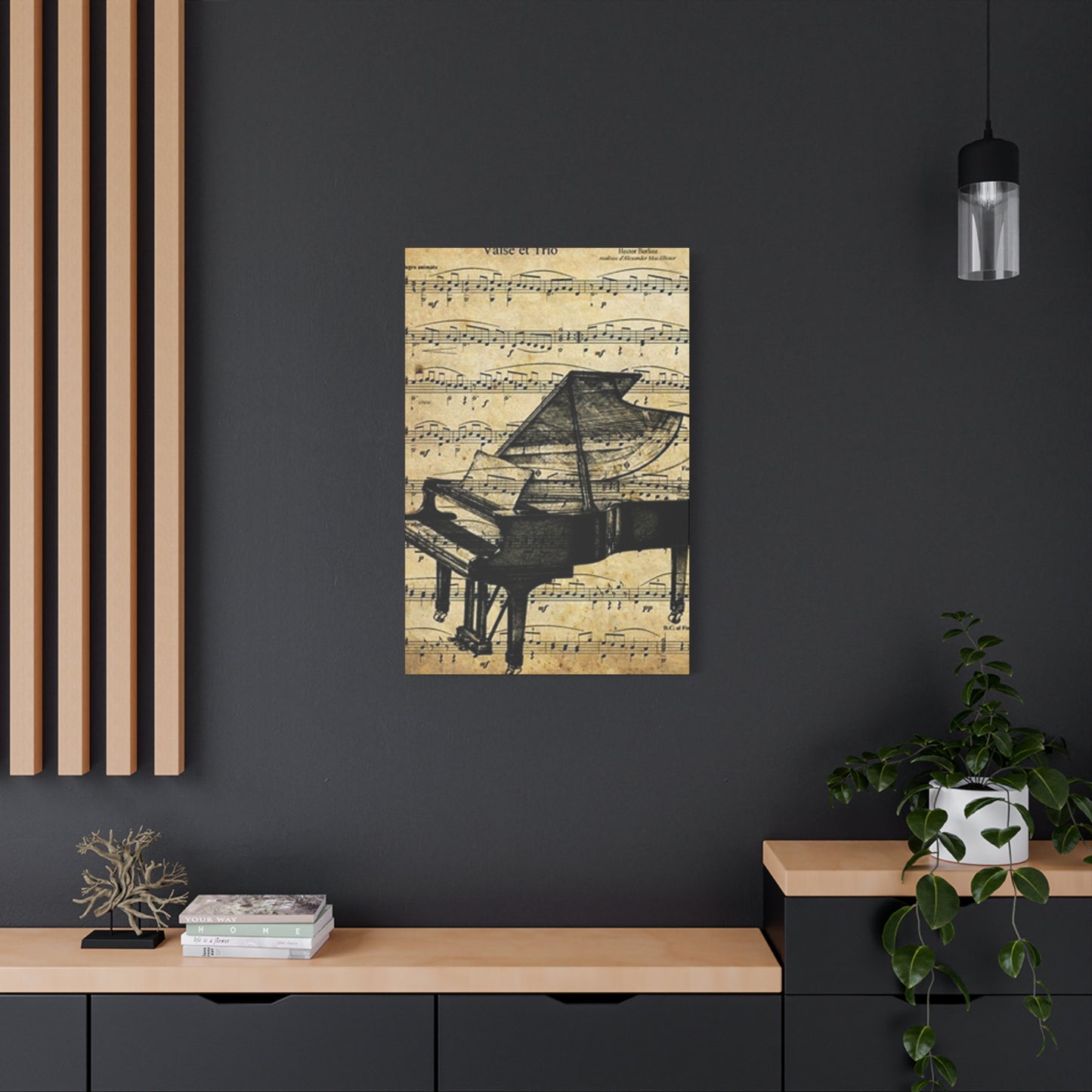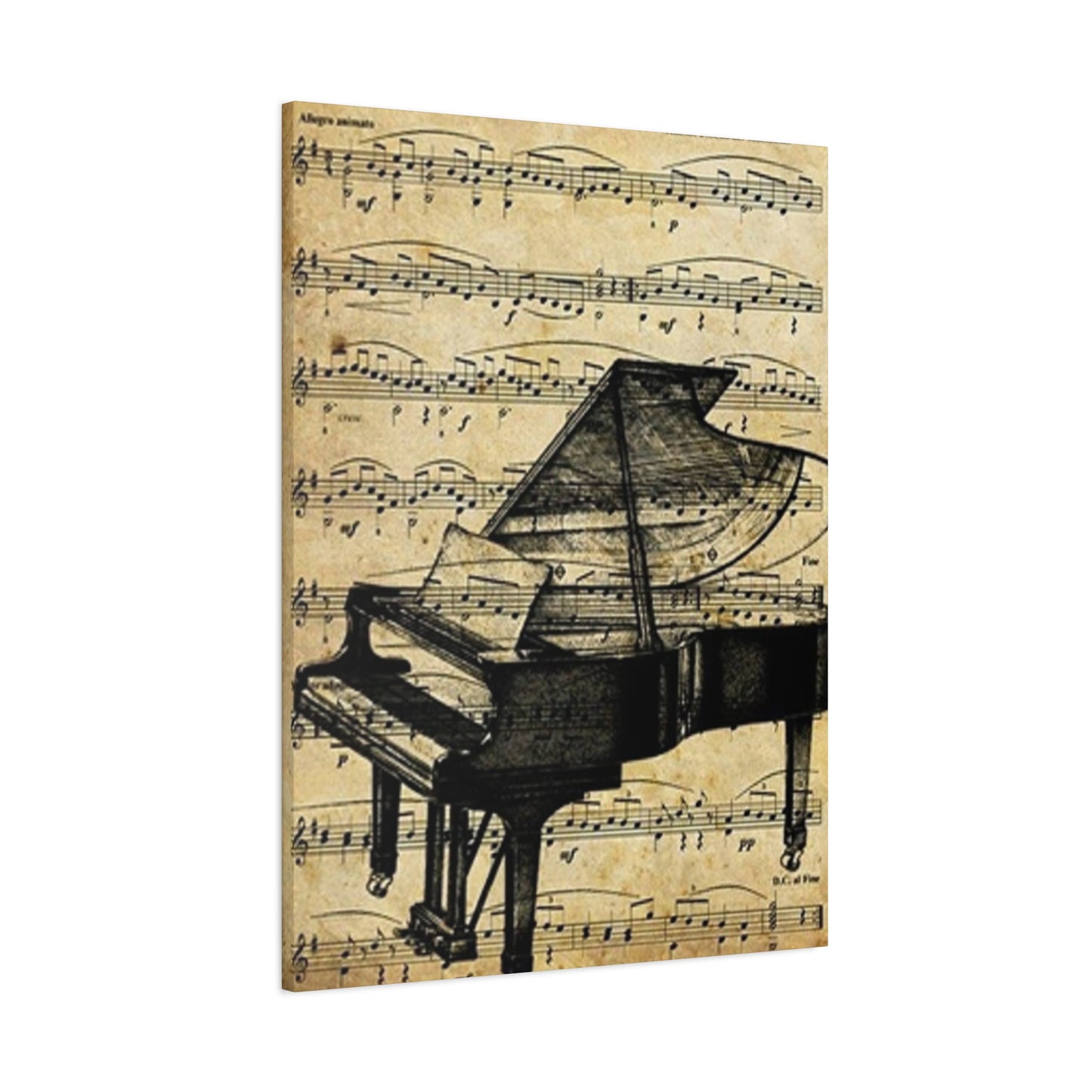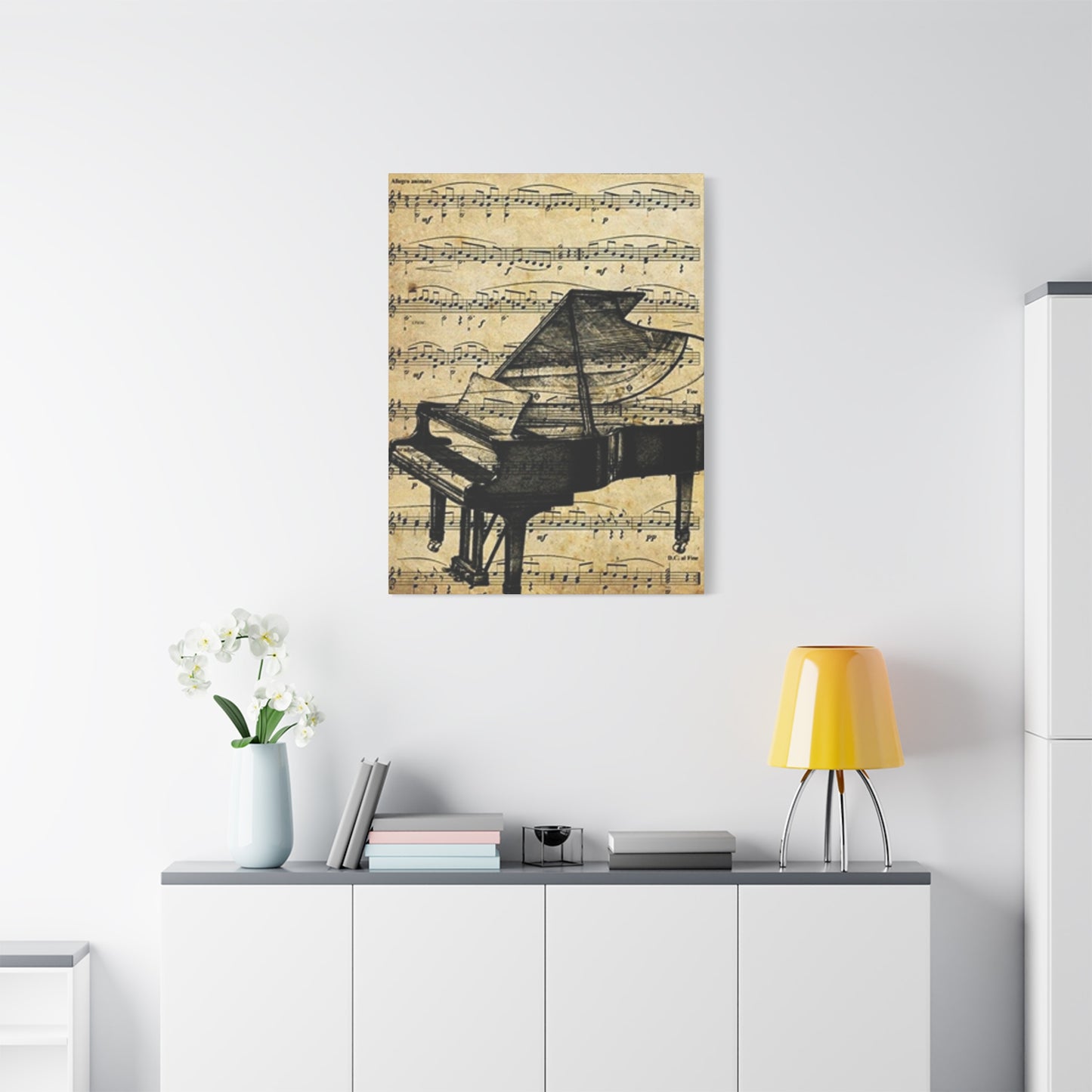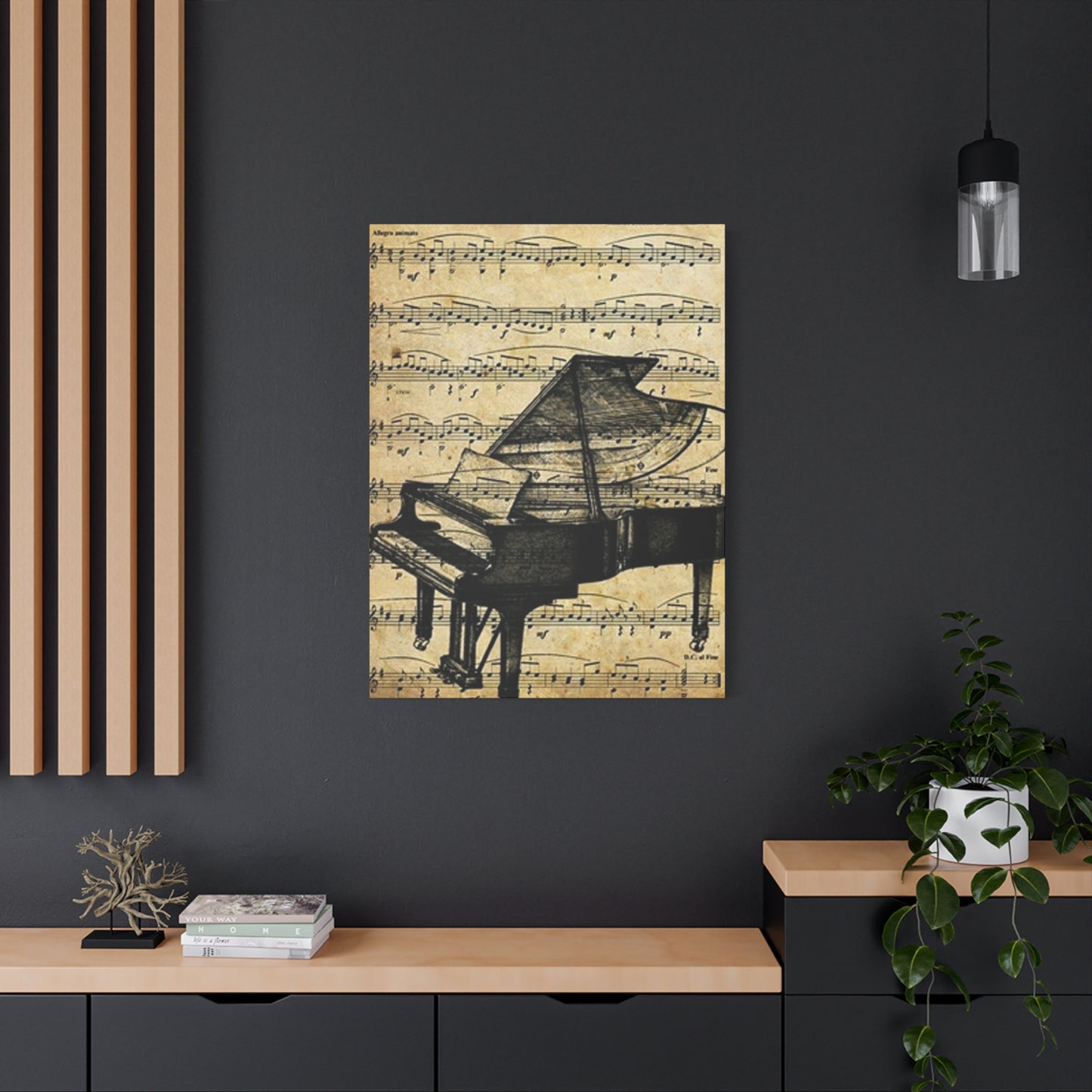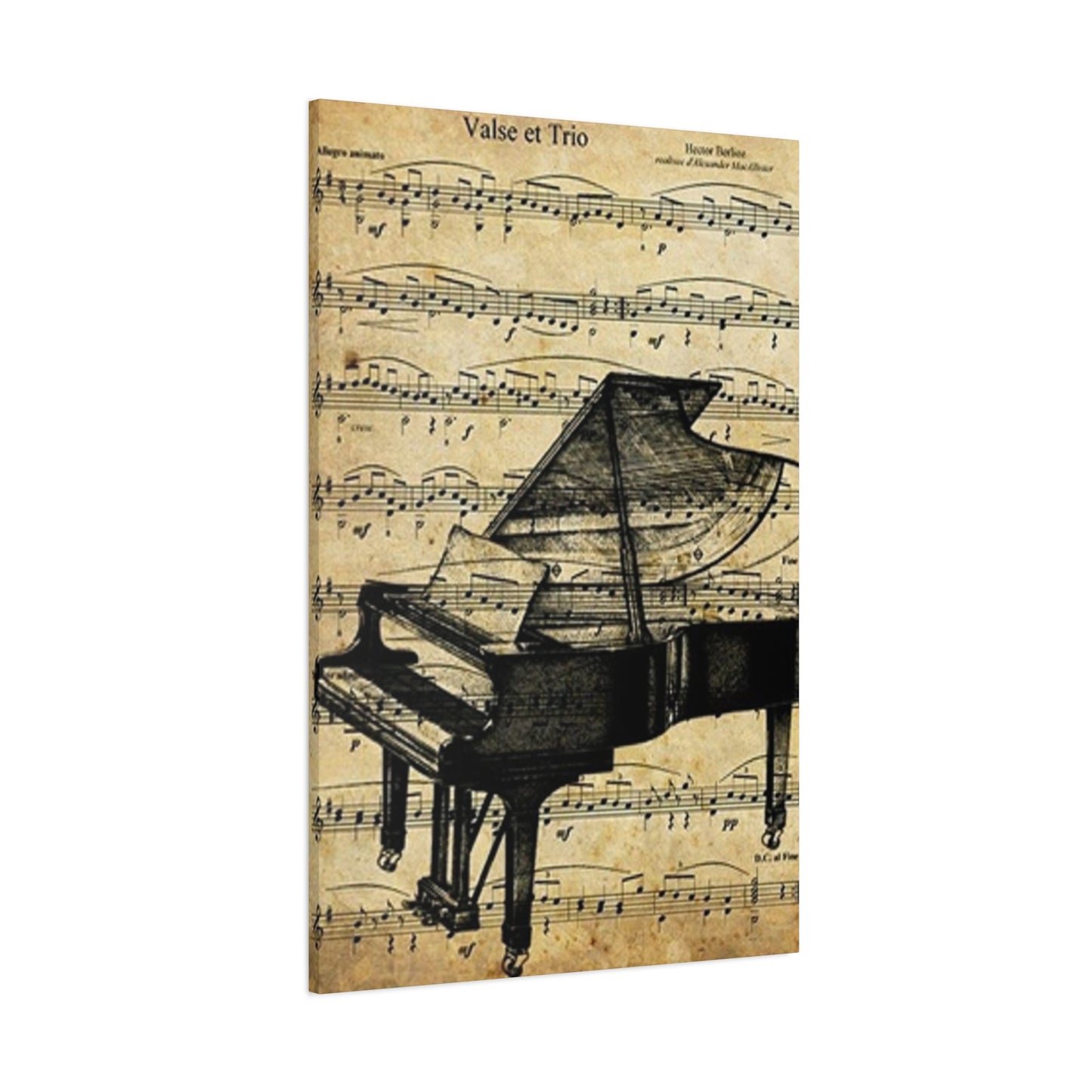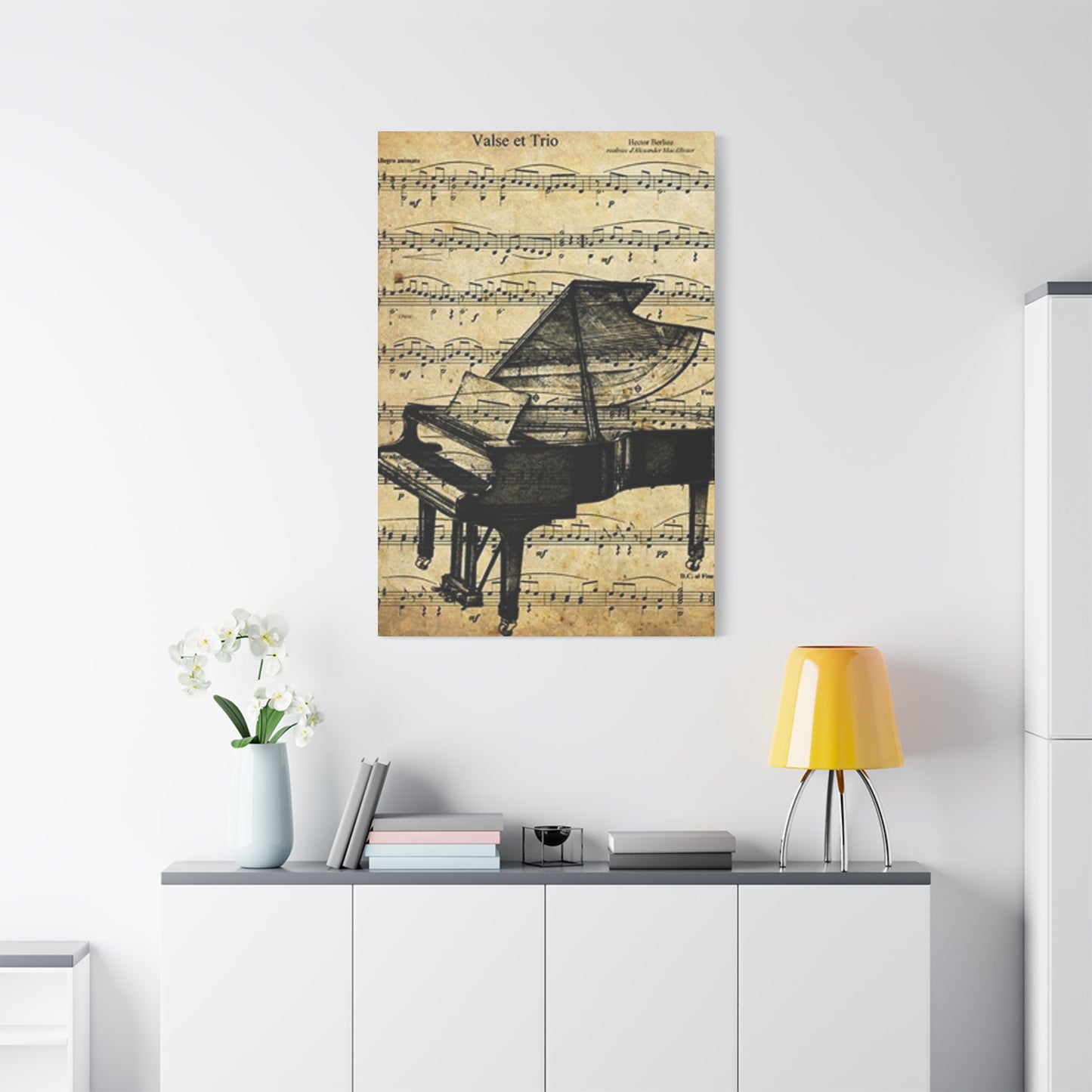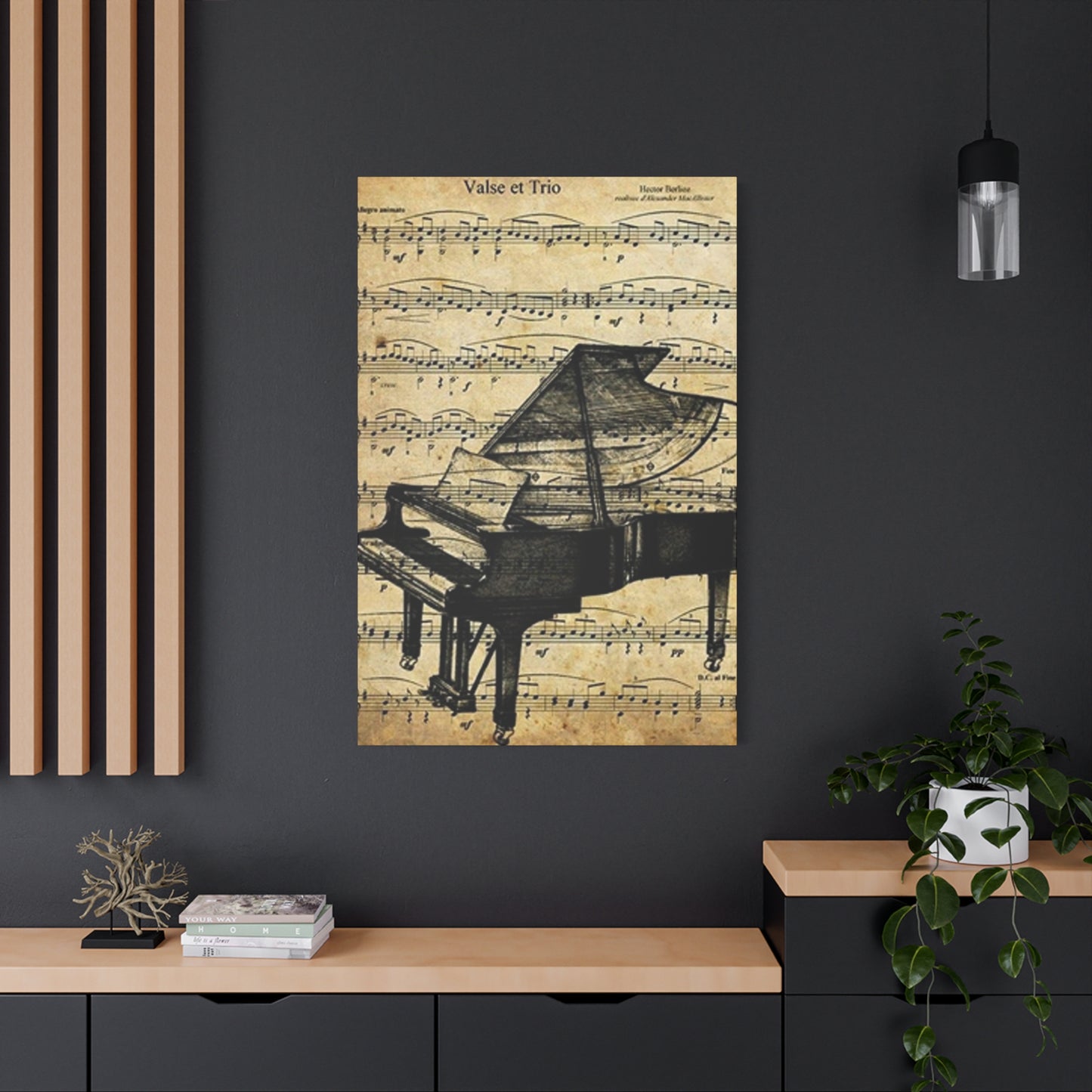Musical Piano Wall Art: Celebrating the Harmony of Sound and Design
Music has always been more than just sound. It is emotion, memory, and expression woven together in harmony. For those who live and breathe melodies, incorporating musical themes into home decor becomes a natural extension of their passion. Piano canvas art offers a unique way to celebrate this love, transforming ordinary walls into inspiring spaces that resonate with creativity and sophistication. This comprehensive exploration delves into the world of musical wall decor, examining how piano-themed artwork can redefine interiors and create environments that reflect the soul of music itself.
Bring Music to Your Walls
The walls of a home tell stories. They hold memories, display personal style, and set the atmosphere for daily life. When you introduce musical elements into your interior design, you are not just adding decoration—you are infusing your living space with the very essence of what moves you. Piano canvas art serves as a visual representation of passion, dedication, and artistic appreciation.
Choosing to adorn your walls with musical imagery creates an immediate connection between your physical environment and your emotional landscape. Every glance at a beautifully rendered piano piece or a cascade of musical notation reminds you of the melodies that have shaped your life. This constant visual presence can inspire creativity, evoke cherished memories, and provide comfort during quiet moments.
The beauty of bringing music to your walls lies in the versatility of the concept. Whether you prefer bold, dramatic pieces featuring grand pianos in striking compositions or subtle, elegant designs showcasing delicate musical notes floating across canvas, there exists an artwork perfectly suited to your taste. The key is selecting pieces that genuinely resonate with your personal aesthetic while complementing the existing design elements in your space.
Musical wall art transcends mere decoration. It becomes a conversation starter, inviting guests to share their own musical experiences and memories. It signals to visitors that this is a home where art and culture are valued, where creativity flourishes, and where beauty is appreciated in all its forms. The impact of thoughtfully chosen piano canvas art extends far beyond the visual, touching the hearts of everyone who enters the space.
When considering how to bring music to your walls, think about the emotions you wish to evoke. Do you want to create an energetic, inspiring atmosphere that motivates creative pursuits? Or perhaps you prefer a serene, contemplative environment where you can unwind to the imagined sounds of gentle piano melodies? The artwork you select will play a crucial role in establishing the desired mood and character of each room.
Piano Art That Hits the Right Note
Finding artwork that truly resonates requires more than simply selecting an attractive image. The perfect piano canvas art speaks directly to your soul, capturing something essential about your relationship with music. It might be the way light plays across piano keys in a particular piece, the dynamic arrangement of musical elements, or the color palette that mirrors your emotional response to your favorite compositions.
Piano art that hits the right note combines technical excellence with emotional depth. The artist's skill in rendering the instrument itself—capturing the elegant curves of a grand piano, the precise geometry of the keys, or the intricate details of the hammers and strings—demonstrates mastery of craft. Yet technical proficiency alone cannot create truly moving artwork. The piece must also convey feeling, whether it is the joy of performance, the solemnity of classical composition, or the intimate connection between musician and instrument.
Consider the various styles available when searching for piano canvas art. Realistic depictions offer classical beauty, presenting the instrument in all its physical glory with meticulous attention to detail. These pieces often feature dramatic lighting that emphasizes the piano's sculptural qualities, creating a sense of grandeur appropriate for formal spaces or music rooms. The realism in such artwork appeals to those who appreciate traditional artistic approaches and want to celebrate the piano as both functional instrument and aesthetic object.
Abstract interpretations provide an entirely different experience. These pieces deconstruct the piano into its essential elements—keys become geometric patterns, strings transform into sweeping lines, and the overall form dissolves into suggestions of movement and sound. Abstract piano art appeals to those with contemporary tastes who appreciate artwork that stimulates imagination and invites personal interpretation. Such pieces often feature bold color choices and dynamic compositions that energize spaces with modern sensibilities.
Vintage-inspired piano artwork offers nostalgic charm, often incorporating elements like aged sheet music, antique pianos, and sepia-toned color schemes. These pieces evoke the romance of bygone eras when piano parlors were central to home entertainment and social gatherings. They work beautifully in spaces with vintage or shabby chic decor themes, adding authentic period character while celebrating the enduring legacy of piano music.
Decor That Feels Like a Symphony
Creating an interior design scheme that feels like a symphony requires careful orchestration of various elements. Piano canvas art serves as a crucial component in this harmonious arrangement, working in concert with furniture, lighting, textiles, and accessories to produce a cohesive and emotionally resonant environment. The goal is to achieve balance—ensuring that no single element overwhelms the composition while allowing each piece to contribute its unique voice to the overall aesthetic.
Symphonic decor begins with understanding the principles of visual harmony. Just as a musical composition balances different instruments, tones, and rhythms, successful interior design balances colors, textures, shapes, and proportions. Piano canvas art provides a focal point around which other design decisions can revolve. The colors present in the artwork might inspire your choices for throw pillows, curtains, or accent furniture. The style of the piece—whether traditional, modern, or eclectic—can guide the overall design direction for the space.
Layering is essential in creating decor that truly feels symphonic. A single piece of piano art on an otherwise bare wall might look isolated and incomplete. Instead, consider building visual interest through thoughtful arrangement. Flank your primary piano canvas with complementary pieces—perhaps vintage concert posters, framed sheet music, or photographs of famous concert halls. Add dimensional elements like wall-mounted shelves displaying small musical instruments, decorative metronomes, or collections of music boxes.
Lighting plays the role of conductor in your decorative symphony, directing attention and setting the mood. Proper illumination can transform piano canvas art from pleasant decoration into breathtaking focal point. Picture lights mounted above artwork provide focused illumination that highlights details and creates dramatic shadows. Track lighting offers flexibility, allowing you to adjust emphasis as needed. Even strategic placement near windows can harness natural light to make colors more vibrant during daylight hours while creating interesting silhouettes at dusk.
The textiles in your space contribute texture and softness to the visual symphony. Consider how curtains, rugs, and upholstery fabrics can echo or complement the themes present in your piano artwork. A canvas featuring rich burgundy tones might be beautifully complemented by velvet cushions in similar shades. Artwork with gold metallic accents could inspire the addition of silk or satin textiles that catch light in similarly luxurious ways.
Elegant Wall Art for Music Lovers
Elegance in wall art emerges from the marriage of refined aesthetics and meaningful content. For music lovers, elegant piano canvas art represents more than simple decoration—it is an expression of identity, a celebration of passion, and a testament to the transformative power of music. Elegant pieces distinguish themselves through sophisticated composition, thoughtful color choices, and an ineffable quality that commands respect without demanding attention.
True elegance never shouts. Instead, it speaks in measured tones, confident in its beauty and secure in its worth. Elegant piano wall art often features restrained color palettes—perhaps monochromatic schemes of blacks, whites, and grays that emphasize form over flash, or carefully selected jewel tones that add richness without overwhelming. The composition demonstrates balance and poise, with each element purposefully placed to contribute to the overall harmony of the piece.
Classical subjects lend themselves naturally to elegant treatment. A grand piano positioned in an ornate concert hall, rendered in muted tones with careful attention to architectural details, exudes timeless sophistication. Musical notation from famous compositions, presented with the reverence of historical documents, carries inherent elegance through its association with musical genius. Even abstract interpretations can achieve elegance through careful consideration of line, form, and negative space.
The choice of medium affects perceived elegance significantly. Canvas prints offer texture and depth that paper prints cannot match, lending artwork a gallery-quality presence. The weave of the canvas becomes part of the visual experience, adding subtle dimensionality that enhances the overall impression of quality. Stretched canvas mounted on wooden frames presents artwork as serious art rather than mere decoration, signaling that the piece has been selected with discernment and care.
Size considerations matter when selecting elegant wall art. Oversized pieces make bold statements, claiming their place in the visual hierarchy of a room with confidence. However, elegance does not require large scale. A modestly sized canvas, perfectly framed and expertly positioned, can possess tremendous elegance through the precision of its presentation. Gallery walls featuring multiple smaller pieces arranged with mathematical precision demonstrate elegant restraint while showcasing sophisticated curation skills.
For music lovers seeking elegant wall art, the emotional resonance of the piece must align with personal experience. A canvas that beautifully depicts a piano but fails to stir any genuine feeling will always seem hollow, no matter how technically accomplished. True elegance comes from the connection between artwork and viewer—the moment when visual beauty intersects with emotional truth to create something genuinely meaningful.
Let the Music Flow Through Your Space
Spaces possess energy. Some rooms feel vibrant and alive, pulsing with creative potential. Others exude calm tranquility, offering refuge from the chaos of daily life. The artwork you select profoundly influences this energetic quality, and piano canvas art specifically can direct the flow of musical energy throughout your environment, creating pathways for inspiration and harmony.
Allowing music to flow through your space requires intentional placement of musical elements. Rather than concentrating all piano artwork in a single room, consider distributing pieces throughout your home to create a cohesive thematic thread. An elegant piano canvas in the entryway sets the tone immediately upon arrival, announcing to residents and visitors alike that this is a home where music matters. Continuing the theme into living areas, hallways, and even bedrooms maintains the musical narrative while adapting the specific style and mood to suit each space's function.
The concept of flow relates directly to visual movement within a space. The human eye naturally seeks pathways through a room, following lines, shapes, and patterns from one focal point to another. Piano canvas art can guide this visual journey, creating rhythm and continuity that mirrors musical composition. A series of canvases depicting different aspects of piano performance—perhaps hands on keys, internal mechanism, full instrument—arranged in sequence along a hallway creates a visual crescendo that draws people forward through the space.
Color serves as another conduit for musical flow. By selecting piano artwork that shares common color elements with other pieces throughout your home, you establish visual harmony that unifies disparate spaces into a coherent whole. A golden-toned piano canvas in the living room might echo the warm metallics in a music-themed piece in the dining area, creating subliminal connection that makes the entire home feel thoughtfully designed rather than randomly decorated.
Musical flow extends beyond visual elements to encompass the actual experience of sound within your space. Consider how your piano canvas art relates to the music you play in various rooms. Artwork featuring dramatic, powerful imagery of grand pianos might pair beautifully with spaces where you enjoy orchestral works or bold contemporary compositions. Softer, more intimate depictions of piano keys or musical notation could enhance areas where you prefer gentle jazz, classical piano solos, or ambient soundscapes.
Creating spaces where music can truly flow means removing obstacles—both physical and psychological—that impede creativity and appreciation. Clutter disrupts visual harmony, making it difficult to focus on the beauty of your carefully selected artwork. Thoughtful organization and minimalist principles allow piano canvas art to breathe, giving each piece room to make its full impact without competing for attention with unnecessary objects.
Chic and Classy Piano Wall Decor
Chicness represents a particular aesthetic sensibility characterized by effortless style, contemporary awareness, and subtle sophistication. When applied to piano wall decor, this quality manifests in artwork that feels current and fashion-forward while maintaining timeless appeal. Chic piano canvases often feature clean lines, unexpected color combinations, and modern interpretations of classical subjects that bridge the gap between traditional musical imagery and contemporary design trends.
The chic approach to piano wall decor embraces boldness tempered by restraint. A striking black and white photograph of piano keys, presented in extreme close-up that emphasizes geometric patterns and tonal contrasts, achieves chicness through its confident simplicity. The subject itself is traditional and familiar, yet the treatment feels fresh and modern. This balance between the known and the novel characterizes truly chic design.
Color plays a pivotal role in achieving chic aesthetics. While classic combinations like black and white remain perennially stylish, chic piano wall decor might incorporate unexpected hues—blush pink backgrounds with gold piano illustrations, or teal and copper combinations that feel both luxurious and contemporary. These color choices demonstrate awareness of current design trends while avoiding the trap of being so trendy that they will quickly feel dated.
Mixed media approaches contribute to chic piano wall decor by adding textural interest and dimensional complexity. Canvas prints that incorporate metallic inks create shimmer and shine, catching light in dynamic ways that change throughout the day. Artwork featuring combinations of photography, illustration, and typography achieves layered sophistication that rewards closer examination. Three-dimensional elements like wood or metal accents transform flat canvas into sculptural statement pieces.
The framing and presentation of piano wall decor significantly impacts its chic factor. Floating frames that create space between canvas and frame add modern architectural interest. Gallery-style presentation without traditional frames at all keeps focus on the artwork itself while projecting confident minimalism. Even the choice to leave canvas edges unframed, allowing the continuation of the image around the sides, represents a chic approach that emphasizes the artwork as object rather than merely image.
Classiness, while related to chicness, brings additional elements of refinement and understated luxury. Classy piano wall decor never tries too hard or announces itself too loudly. Instead, it relies on quality materials, expert craftsmanship, and tasteful design to convey its worth. The difference between a mass-produced poster and a genuine canvas print illustrates this distinction—both might feature identical images, yet the latter possesses inherent classiness through superior materials and presentation.
Musical Notes in Motion on Canvas
Musical notation possesses inherent visual beauty. The staff lines provide structure, while notes dance across them in patterns that represent both mathematical precision and emotional expression. When translated to canvas, musical notes become design elements capable of creating striking artwork that appeals to musicians and non-musicians alike. The representation of notes in motion adds dynamic energy to static images, suggesting the movement of music through time and space.
Artwork featuring musical notes in motion often employs techniques that suggest flow and energy. Notes might appear to drift off the staff, floating freely across the canvas like leaves caught in wind. This visual metaphor represents the way music fills space, transcending physical boundaries to touch hearts and minds. The flowing arrangement creates visual rhythm that guides the eye through the composition while evoking the temporal nature of musical performance.
Color application in musical note artwork dramatically affects the overall impression. Traditional black notes on white or cream backgrounds maintain classical elegance and ensure legibility, making such pieces appropriate for formal spaces or traditional decor schemes. However, contemporary interpretations might reverse this convention, featuring white notes on dark backgrounds for dramatic impact. Some pieces incorporate rainbow color progressions, with notes gradually shifting hue as they move across the canvas, suggesting the emotional range and tonal variation within musical compositions.
The size and scale of musical notes within canvas art determines whether the piece reads as delicate and detailed or bold and graphic. Oversized notes, presented in extreme close-up, become abstract shapes that non-musicians can appreciate for their pure visual form while those familiar with notation recognize their musical significance. This dual appeal makes musical note artwork particularly versatile, working successfully in various contexts from professional music studios to contemporary living spaces.
Layering multiple elements of musical notation creates complex, visually rich compositions. A canvas might feature a background of lightly rendered sheet music, with key passages or measures highlighted in stronger contrast. Additional layers could include notation rendered at different scales, creating depth and dimensional interest. This technique particularly appeals to musicians who enjoy discovering specific musical references hidden within the artwork.
The motion implied in musical note canvas art can be subtle or pronounced. Gentle curves and flowing lines suggest lyrical, melodic passages—perhaps romantic piano compositions or smooth jazz improvisations. Sharper angles, staccato arrangements, and dynamic diagonals imply energetic, rhythmic music with driving beats and dramatic crescendos. By carefully considering the type of motion depicted, you can select artwork that reflects your preferred musical genres and emotional responses.
Wall Art for the Passionate Pianist
Pianists develop unique relationships with their instruments. Hours of practice create intimate familiarity with the feel of keys beneath fingers, the subtle mechanics of hammer strikes, and the infinite expressive possibilities available through touch and technique. Wall art designed for passionate pianists honors this special connection, celebrating not just the piano itself but the experience of making music with hands, heart, and soul.
Artwork that resonates with pianists often focuses on the points of physical connection between performer and instrument. Close-up images of hands positioned on keys capture the grace and precision required for skilled performance. The positioning of fingers, the arch of the wrist, the gentle curve of knuckles—these details speak volumes to those who understand the physical discipline piano playing demands. Such images serve as reminders of countless practice hours while celebrating the beauty of musical technique.
The internal workings of pianos fascinate many pianists who appreciate the mechanical complexity underlying the instrument's sonic capabilities. Canvas art featuring the intricate arrangement of strings, hammers, dampers, and other internal components appeals to this technical interest. These pieces often employ dramatic lighting that emphasizes the sculptural qualities of piano innards, transforming functional mechanisms into abstract compositions of line, form, and shadow.
For pianists, artwork featuring specific piano types carries particular meaning. Those who perform on grand pianos might prefer artwork showcasing these majestic instruments in concert halls or elegant settings. Upright piano enthusiasts might connect more deeply with artwork featuring these more intimate, domestic instruments. Even specific brands or models might hold special significance for pianists who have memorable associations with particular instruments.
Musical repertoire influences artwork preferences among pianists. Those who specialize in classical performance might gravitate toward artwork incorporating elements of classical composition—perhaps famous scores rendered as decorative elements or period imagery suggesting the historical context of beloved pieces. Jazz pianists might prefer artwork with looser, more improvisational feel, featuring abstract interpretations or vintage jazz club imagery. Contemporary pianists working in modern genres could seek cutting-edge, experimental artwork that reflects their innovative approach to the instrument.
Educational elements can make piano wall art particularly meaningful for dedicated pianists. Artwork incorporating music theory concepts, chord progressions, or technical exercises presented in visually appealing formats serves both decorative and practical purposes. Practice spaces and teaching studios benefit particularly from such artwork, which reinforces pedagogical concepts while beautifying the environment.
Where Sound Meets Style
The intersection of auditory and visual art creates powerful synesthetic experiences. Piano canvas art exists precisely at this crossroads, translating the ephemeral nature of sound into permanent visual form. This transformation allows music lovers to maintain constant connection with their passion, surrounding themselves with imagery that evokes the emotional and sensory experiences of musical performance and appreciation.
Creating spaces where sound meets style requires considering how visual elements enhance or complement actual musical experiences. A beautifully appointed listening room featuring piano canvas art becomes more than the sum of its parts. The artwork enriches the listening experience by providing visual beauty to contemplate during musical moments, while the music brings the artwork to life, suggesting the sounds that might emerge from the depicted instruments.
Style in this context encompasses both aesthetic sensibility and personal expression. Your choices in piano wall art communicate aspects of your identity and values. Selecting avant-garde, contemporary pieces signals openness to innovation and experimental thinking. Choosing classical, traditional artwork suggests appreciation for heritage and timeless beauty. Eclectic mixes demonstrate comfort with complexity and embrace of diverse influences. Each approach represents valid stylistic choice, with the best option being whichever most authentically represents your genuine preferences.
The materials and craftsmanship involved in creating piano canvas art contribute significantly to the point where sound meets style. High-quality canvas, professional-grade printing techniques, and expert stretching and mounting all ensure that artwork does justice to its subject matter. Just as musicians demand quality instruments capable of producing beautiful sound, music lovers should seek quality artwork capable of producing beautiful visual impact. Inferior materials and poor execution undermine the artistic intent, much as an out-of-tune piano diminishes even the most skilled performance.
Considering scale and proportion helps optimize the meeting point of sound and style. Grand pianos are physically imposing instruments that command attention in any space. Artwork depicting them benefits from generous sizing that honors their actual scale while creating focal points worthy of their subject. Conversely, intimate close-ups of keyboard details or small musical vignettes might work better in smaller formats that encourage closer viewing and contemplation.
The relationship between sound and style extends to the acoustic properties of your space. Hard surfaces like walls covered with canvas artwork affect how sound reflects and disperses through rooms. While the impact is subtle compared to purposeful acoustic treatment, the presence of canvas art does add slight sound absorption and diffusion. In home music studios or listening rooms where acoustic quality matters, this represents an additional benefit beyond pure aesthetics.
Add Rhythm to Your Room
Rhythm in interior design operates similarly to rhythm in music—it creates patterns of repetition, variation, and progression that guide experience through space and time. Piano canvas art contributes to spatial rhythm through strategic placement, consistent thematic elements, and visual patterns that lead the eye through intentional paths. Understanding and applying rhythmic principles transforms random decoration into thoughtfully orchestrated design.
Regular rhythm establishes through exact repetition of elements at consistent intervals. A hallway featuring identically sized piano canvases spaced at equal distances creates this type of rhythm. The predictability feels orderly and calm, appropriate for spaces where you want to establish tranquility and structure. However, exact repetition can become monotonous if applied too uniformly throughout an entire home. Reserve this approach for specific areas where its particular qualities serve your design goals.
Flowing rhythm employs curved, organic shapes that guide movement in smooth, continuous paths. Piano artwork featuring flowing musical staffs, curved piano forms, or sweeping compositional arrangements contributes to flowing rhythm. This type of visual movement feels natural and relaxing, working beautifully in spaces intended for rest and rejuvenation. Bedrooms and quiet reading nooks particularly benefit from the calming influence of flowing rhythmic elements.
Progressive rhythm builds through gradual changes in size, color, or other characteristics. A series of piano canvases arranged from smallest to largest creates visual crescendo. Alternatively, artwork progressing from light to dark tones or from simple to complex compositions generates forward momentum that propels viewers through space. Progressive rhythm adds excitement and anticipation, making it ideal for areas where you want to energize and inspire.
Alternating rhythm varies between two or more different elements in deliberate pattern. You might alternate between piano canvases and other musical artwork, or between different styles or sizes of piano pieces. This approach creates visual interest through variation while maintaining coherence through the underlying pattern. The interplay between repetition and change keeps spaces feeling dynamic without descending into chaos.
Radial rhythm emanates from a central point, with elements arranged in circular or starburst patterns. While less commonly employed in wall arrangement, creative approaches can incorporate radial rhythm when grouping multiple pieces around a central piano canvas. This focal arrangement draws immediate attention while creating balanced composition that feels complete and resolved.
Perfect Harmony Piano and Notes on Canvas
The combination of piano imagery with musical notation represents natural pairing that appears frequently in canvas art designed for music lovers. This marriage of subject matters creates layered meaning—the piano represents the physical instrument and the act of performance, while notes symbolize the music itself, the compositions that give the instrument purpose. Together, they form complete picture of musical expression.
Achieving perfect harmony in artwork featuring both pianos and notes requires careful balance between elements. The piano should not overwhelm the notation to the point where notes become mere decorative background. Equally, notes should not obscure or diminish the piano's presence. The most successful pieces give appropriate weight to both elements, allowing each to contribute its unique characteristics to the overall composition.
Compositional approaches to combining pianos and notes vary widely. Some artists use notation as literal or suggestive background, perhaps showing sheet music resting on a piano or staff lines stretching across the image plane. Others integrate elements more abstractly, allowing notes to float around, through, or even become part of the piano form itself. This surrealistic approach creates dreamlike quality that emphasizes the mystical, transcendent nature of musical experience.
Color relationships between piano and note elements affect the visual dynamics of combined imagery. High contrast between elements—perhaps stark white notes against a black piano silhouette—creates drama and clarity, ensuring each component reads distinctly. Lower contrast and shared color families create cohesive unity where piano and notes blend harmoniously into single vision. Your choice should reflect whether you want to emphasize the distinct identity of each element or their unified relationship.
Literal representation of actual musical compositions in notation adds additional layer of meaning for those familiar with the pieces. Artwork incorporating recognizable passages from famous piano works allows knowledgeable viewers to "hear" the music when looking at the visual representation. This connection between visual and auditory memory creates particularly powerful experience for those who have performed or deeply studied the referenced compositions.
The scale relationship between piano and notes influences reading of the artwork. Oversized notes relative to the piano might suggest music transcending the physical instrument, taking on life of its own beyond mere mechanical sound production. Conversely, small notes relative to large piano emphasize the instrument itself as primary focus, with music serving as context or atmosphere rather than equal subject.
Turn Any Room into a Music Lounge
Music lounges possess distinct character—they are spaces dedicated to acoustic pleasure, designed to facilitate both active listening and social interaction centered around musical appreciation. Through thoughtful application of piano canvas art and complementary design elements, any room can acquire this sophisticated, culturally rich atmosphere regardless of its original purpose or architectural features.
Transforming a room into a music lounge begins with establishing a clear focal point, and piano canvas art serves this purpose brilliantly. A substantial piece featuring a grand piano or musical scene becomes the visual anchor around which all other design decisions revolve. Position furniture to orient toward this focal point, creating natural gathering arrangement that encourages conversation and shared appreciation of both the artwork and actual music played in the space.
Lighting design proves crucial in establishing lounge atmosphere. Music lounges typically favor warmer, softer lighting over harsh overhead illumination. Table lamps, floor lamps, and wall sconces create pools of gentle light that establish intimate mood while providing adequate illumination for reading or conversation. Dimmer switches offer flexibility, allowing you to adjust brightness to match different activities and times of day. Accent lighting specifically directed at piano canvas art elevates these pieces from decoration to gallery-quality displays.
Seating arrangements in music lounges prioritize comfort and conversation. Deep, plush seating invites settling in for extended listening sessions. Arrange furniture in clusters that facilitate small group interaction rather than theater-style rows that discourage social connection. Include variety of seating options—sofas for relaxed lounging, armchairs for those who prefer more upright posture, floor cushions for casual atmosphere—to accommodate different preferences and activities.
Acoustic considerations enhance the lounge experience. While extensive acoustic treatment may be unnecessary for casual listening spaces, some attention to sound quality elevates the environment. Area rugs absorb sound and reduce echo, particularly important in rooms with hard flooring. Heavy curtains over windows provide similar acoustic benefit while also controlling light and adding textural richness. The canvas artwork itself contributes subtly to room acoustics, softening harsh reflections that occur on bare walls.
Accessorizing completes the transformation. Coffee table books about music history, jazz, or piano performance reinforce the theme while providing entertainment for guests. A selection of vintage vinyl records displayed in attractive holders adds nostalgic charm and provides actual musical content. A quality sound system, essential for any music lounge, should integrate tastefully with the decor rather than dominating it with obtrusive equipment. Consider furniture pieces designed to house audio components while maintaining aesthetic consistency with your chosen design direction.
Classic Tunes, Timeless Art
Certain musical compositions transcend their creation periods to become timeless classics, beloved by generation after generation of listeners. Similarly, certain artistic approaches and subjects achieve timeless quality, remaining relevant and beautiful regardless of changing trends. Piano canvas art that captures this timeless essence offers lasting value, continuing to enhance spaces and inspire viewers for years or even decades after initial selection.
Timelessness in piano artwork often relates to classical subject matter presented with technical excellence and artistic sensitivity. A masterfully rendered grand piano, its elegant form captured with attention to proportion, light, and detail, possesses inherent timelessness. The subject itself—an instrument essentially unchanged in fundamentals for over a century—carries historical weight and permanence. When executed with skill and respect for the subject, such artwork transcends momentary fashion to achieve enduring appeal.
Black and white photography of pianos frequently achieves timeless quality. The absence of color eliminates date-specific hues that might eventually feel outdated, while the stark tonal contrasts emphasize form, composition, and emotional content over surface decoration. Historical photographs of pianos in concert halls, music schools, or domestic settings carry additional timeless appeal through their documentary quality, preserving moments from musical history while remaining aesthetically relevant in contemporary contexts.
Famous piano compositions represented through notation or abstract imagery gain timeless status through their associations with musical masterworks. Artwork incorporating visual references to Beethoven, Chopin, Mozart, or other canonical composers taps into cultural heritage that extends across centuries. These pieces appeal to continuous stream of music lovers who discover these compositions anew in each generation, ensuring ongoing relevance and appreciation.
The materials and production methods employed in creating piano canvas art affect longevity and timeless appeal. Archival-quality inks that resist fading ensure colors remain true for decades. Canvas materials that resist yellowing, stretching, or deterioration maintain the artwork's original appearance despite years of display. Professional stretching and mounting techniques prevent sagging or warping that would compromise the presentation. These quality considerations determine whether artwork maintains its beauty across years or deteriorates into disappointing shadow of its original state.
Avoiding overly trendy elements helps ensure timeless appeal. While contemporary trends can be exciting and visually striking, they often have limited lifespan before feeling dated. Neon colors, geometric patterns derived from passing design movements, or heavily stylized treatments that feel specifically tied to particular decades may lose appeal as preferences evolve. If long-term satisfaction matters more than being cutting-edge, gravitate toward classical approaches that have already proven their enduring beauty across extended periods.
A Grand Look for Grand Piano Fans
Grand pianos represent the pinnacle of piano design, offering superior sound quality, impressive visual presence, and undeniable status. For enthusiasts of these magnificent instruments, artwork celebrating their beauty and grandeur creates particular connection and satisfaction. Grand piano artwork ranges from photorealistic depictions capturing every detail to abstract interpretations emphasizing the instrument's elegant form and cultural significance.
The visual magnificence of grand pianos stems from their perfect marriage of function and aesthetics. The sweeping curves of the rim, the graceful legs, the elevated lid revealing internal complexity—every aspect serves both practical purpose and visual beauty. Artwork that captures this dual nature appeals to grand piano enthusiasts who appreciate both technical and aesthetic dimensions of their beloved instruments. Detailed renderings that showcase craftsmanship satisfy those who understand the precision engineering underlying the instrument's capabilities.
Historical context enriches grand piano artwork significantly. Pieces depicting grand pianos in historic concert halls, famous recording studios, or period domestic settings evoke the rich heritage of piano performance. Images of vintage concert grands, with their distinctive styling and patina of age, carry romantic associations with legendary performers and historic performances. This historical dimension adds depth of meaning that transcends pure visual appeal, connecting contemporary viewers with continuity of musical tradition.
The concert hall setting appears frequently in grand piano artwork, and for good reason. These images capture pianos in their element, positioned on stage under dramatic lighting, prepared for performance. The vastness of the hall provides context that emphasizes the piano's role as solo instrument capable of filling large spaces with sound. Empty concert halls with solitary pianos suggest anticipation, the calm before performance. Images captured during concerts, with performers and audiences present, convey energy and shared experience of live musical performance.
Intimate portrayals of grand pianos in domestic settings offer contrasting appeal. These pieces celebrate the piano as personal treasure rather than public instrument. A grand piano positioned near windows with natural light streaming across its polished surface suggests quiet practice sessions and private musical moments. Such imagery resonates with those fortunate enough to have grand pianos in their homes, validating their choice while providing artistic representation of their personal experience.
The mechanical complexity visible when a grand piano's lid is raised fascinates many enthusiasts. Artwork featuring interior views showcases the remarkable engineering that produces the instrument's sound. The geometric arrangement of strings, the precise positioning of hammers, the intricate action mechanisms—these elements create compelling abstract compositions even for viewers who don't understand their function. For knowledgeable piano fans, such images offer opportunity to appreciate the technical mastery that enables musical expression.
Feel the Music Every Day
Daily exposure to beauty and inspiration profoundly affects quality of life. Piano canvas art provides this constant positive presence, enriching everyday experience through visual beauty that references beloved musical realm. Unlike actual music, which exists in time and requires active engagement, visual art remains continuously present, offering its gifts even during moments when you're not consciously attending to it.
The psychological impact of surrounding yourself with meaningful art extends beyond conscious appreciation. Environmental psychology research demonstrates that people's surroundings significantly influence mood, productivity, and overall wellbeing. Art that resonates with personal interests and values creates environments where people feel more authentic and comfortable. For music lovers, piano-themed artwork validates and celebrates this core aspect of identity, creating spaces that feel genuinely "theirs" in deep, personal way.
Positioning piano canvas art in spaces you occupy daily maximizes its positive impact. Artwork in your bedroom offers visual beauty to appreciate during quiet morning moments or before sleep. Pieces in home offices provide inspiring breaks from work, allowing brief mental respite while reminding you of passions beyond professional obligations. Kitchen and dining area artwork enriches daily routines, elevating mundane activities by surrounding them with beauty and meaning.
The relationship between visual art and musical practice deserves consideration for active musicians. Practicing instrument requires discipline and can sometimes feel tedious, particularly when working on technical exercises or challenging passages. Inspirational piano artwork in practice spaces serves as visual reminder of why the effort matters, connecting daily discipline to larger love of music. During frustrating practice sessions, a glance at beautiful piano canvas can renew motivation and reframe struggle as part of meaningful pursuit.
Seasonal variations in natural light affect how artwork appears throughout the year. Piano canvases positioned near windows transform with changing light conditions—warm afternoon sun emphasizes certain colors and creates dramatic shadows, while soft morning light produces entirely different character. This natural variation ensures that artwork remains fresh and interesting despite daily viewing, revealing new aspects as environmental conditions shift.
The cumulative effect of daily exposure to inspirational piano art operates subtly but significantly. Individual moments of aesthetic appreciation might seem minor, but their accumulation across weeks, months, and years shapes your relationship with your environment and reinforces connection to musical passion. This constant, gentle reinforcement of values and interests contributes to sense of consistency and authenticity in life.
From Sheet Music to Wall Masterpiece
Sheet music represents functional beauty—pages designed primarily for communication of musical information that nonetheless possess inherent visual appeal. The transformation from utilitarian document to decorative masterpiece involves recognizing and emphasizing these aesthetic qualities while presenting the material in ways that honor both its musical origins and artistic potential.
Vintage sheet music carries particular appeal due to its historical associations and distinctive graphic design. Covers from early twentieth century often featured elaborate typography, decorative borders, and illustration work that reflected design trends of their periods. These elements, combined with the aged paper quality and occasional wear, create authentic vintage character that contemporary reproductions cannot fully replicate. Canvas art incorporating these vintage sheet music covers celebrates musical history while adding period charm to contemporary spaces.
The notation itself, when properly presented, creates striking visual patterns. The staff lines provide strong horizontal structure, while notes, rests, and other musical symbols create varied rhythms and textures across this framework. Close-up presentations that emphasize these patterns allow viewers to appreciate the visual composition independent from musical content. This approach makes sheet music artwork accessible to non-musicians while still providing musical depth for those who can read notation.
Meaningful sheet music selection adds personal significance to artwork. Using scores from favorite compositions, pieces you've performed, or music associated with important memories transforms generic decoration into personal treasure. Some artists and services specialize in creating custom canvas art from customer-provided sheet music, allowing you to convert meaningful scores from your own collection into professional wall displays.
Conclusion
Music has a unique way of transcending time, space, and emotion, creating experiences that resonate deep within us. Musical piano wall art captures this essence, transforming the elegance and rhythm of the piano into visual expression. Every key, every curve of the instrument, and every subtle shadow in these artworks tells a story of creativity, discipline, and harmony. Bringing such art into your home does more than decorate walls—it invites the soul of music into your living space, bridging the auditory beauty of sound with the visual poetry of design.
Piano wall art is versatile, offering something for every interior style. In contemporary spaces, monochrome prints of a grand piano’s keys or abstract representations of sheet music add sophistication and focus. In traditional or vintage-inspired interiors, richly colored depictions of a piano in a warm, intimate setting evoke nostalgia and emotional depth. Regardless of style, the artwork creates an atmosphere where elegance and artistry coexist, turning walls into visual symphonies that resonate with both music lovers and casual admirers alike.
What makes piano-themed art particularly compelling is its ability to symbolize balance and harmony. The piano itself is a microcosm of contrast: black and white keys, soft and loud notes, simple melodies and complex compositions. This duality translates beautifully into wall art, reminding us that beauty is often found in opposites working together. When displayed in a living room, studio, or office, piano art encourages reflection on the harmony in our own lives—the balance between ambition and relaxation, creativity and structure, chaos and calm.
The visual composition of piano wall art also offers a sense of rhythm and movement. Abstract or impressionistic designs can evoke the flow of music across a room, while realistic depictions of pianos in intimate spaces create moments of calm and inspiration. Large canvases can dominate a wall with a dramatic presence, while smaller pieces can be grouped to create a gallery that feels like a curated performance of artistic expression. Each piece captures the essence of sound in a way that transforms static walls into immersive experiences.
Lighting plays a crucial role in enhancing piano artwork. Spotlights or directional lighting can highlight the keys or contours of the piano, creating depth and focus. In dimmer spaces, soft ambient light can accentuate brushstrokes or textures, giving the impression that the piano is almost alive, inviting viewers to imagine the music that could emerge from its keys. The interplay of light and shadow mirrors the dynamics of musical performance itself, reinforcing the connection between visual and auditory art.
Piano wall art also carries deep emotional resonance. The piano represents creativity, passion, and the discipline required to master an art form. For musicians, it can serve as a daily reminder of their dedication and love for music. For non-musicians, it evokes the universal emotions that music inspires—joy, nostalgia, calm, and reflection. By incorporating such artwork into your home, you create an environment where emotional connection and aesthetic beauty intersect, fostering inspiration, focus, and appreciation for the arts.
Color choices in piano artwork enhance its expressive power. Black-and-white depictions emphasize clarity, structure, and timelessness. Warm tones, such as browns and golds, add intimacy and comfort, while abstract interpretations with bold colors infuse energy and dynamism into any room. Paired with modern furniture, minimalist décor, or rich textures, piano wall art can either harmonize subtly or serve as a striking centerpiece that draws the eye and captures attention.
Ultimately, musical piano wall art is more than a visual decoration—it is a celebration of creativity, rhythm, and emotional resonance. It bridges the gap between music and design, reminding us that art is multi-dimensional, engaging both the senses and the imagination. Each glance at a piano print or painting is an invitation to reflect on harmony, elegance, and the transformative power of artistry.
By displaying piano wall art, your space becomes a tribute to the beauty of sound and the sophistication of design. It encourages creativity, nurtures reflection, and elevates the ambiance of any room. Whether in a living room, studio, bedroom, or office, the presence of piano imagery transforms walls into expressions of rhythm, emotion, and aesthetic grace. In this way, your home becomes more than a place to live—it becomes a sanctuary where music and art converge, inspiring every moment with the timeless harmony of design and sound.

















